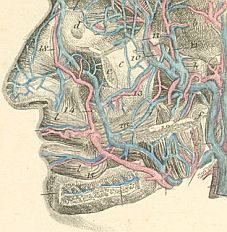 Arteria facialis: nace de la cara anterior de la carótida externa, por encima de la lingual. Se dirige hacia arriba adosada a la pared faríngea, pasa por debajo del digástrico y del estilo-hioideo, penetrando en la celda submaxilar. Contornea la glándula pasando por encima de ella, describiendo la llamada curva faríngeo o supraglandular, enseguida describe una segunda curva submaxilar para rebasar el borde de la mandíbula, así alcanza la cara, dirigiéndose hacia la comisura de los labios, ascendiendo después para recorrer el surco nasogeniano y termina en el ángulo interno del ojo, anastomosándose con la arteria nasal. En su trayecto por la cara es muy sinuosa y descansa sobre el bucinador, el canino y el elevador profundo, está cubierta por el musculocutáneo del cuello, el triangular de los labios y los zigomáticos.
Arteria facialis: nace de la cara anterior de la carótida externa, por encima de la lingual. Se dirige hacia arriba adosada a la pared faríngea, pasa por debajo del digástrico y del estilo-hioideo, penetrando en la celda submaxilar. Contornea la glándula pasando por encima de ella, describiendo la llamada curva faríngeo o supraglandular, enseguida describe una segunda curva submaxilar para rebasar el borde de la mandíbula, así alcanza la cara, dirigiéndose hacia la comisura de los labios, ascendiendo después para recorrer el surco nasogeniano y termina en el ángulo interno del ojo, anastomosándose con la arteria nasal. En su trayecto por la cara es muy sinuosa y descansa sobre el bucinador, el canino y el elevador profundo, está cubierta por el musculocutáneo del cuello, el triangular de los labios y los zigomáticos.
Ramas colaterales: palatina inferior o ascendente; ramos submaxilares; submental; pterigoidea; masetérica; coronaria inferior; coronaria superior; arteria del ala de la nariz.
Ramas terminales: arteria angular.
Sinónimos: arteria maxilar externa.
<(F): Artère faciale: se dirige vers le haut, émergeant de la carotide externe au niveau du cou, au-dessous du muscle mylohyoïdien. Elle chemine le long du maxillaire inférieur, suivant une ligne passant par les coins de la bouche. L'artère suit ensuite un trajet ascendant dans la joue et la paroi latérale de la fosse nasale, jusqu'au canthus interne de l'oeil. L'artère présente de nombreux plis et courbes, lui permettant de s'adapter au mouvement des joues, des lèvres et de la mâchoire. Plusieurs branches se détachent de l'artère faciale et irriguent la face, les amygdales, le palais, les muscles des lèvres, les ailes et le dos du nez, ainsi que les muscles jouant un rôle dans l'expression du visage.
<(Ing): Facial artery: arises in the carotid triangle from the external carotid artery a little above the lingual artery and, sheltered by the ramus of the mandible, passes obliquely up beneath the digastric and stylohyoid muscles, over which it arches to enter a groove on the posterior surface of the submandibular gland. It then curves upward over the body of the mandible at the antero-inferior angle of the masseter; passes forward and upward across the cheek to the angle of the mouth, then ascends along the side of the nose, and ends at the medial commissure of the eye, under the name of the angular artery. This vessel, both in the neck and on the face, is remarkably tortuous: in the former situation, to accommodate itself to the movements of the pharynx in deglutition; and in the latter, to the movements of the mandible, lips, and cheeks.
ANATOMÍA:
-
ANATOMY OF THE HUMAN BODY. <(Ing)
- IKONET.COM. (F)
-
IMAIOS. <(Ing)
FUENTES DE INFORMACIÓN BIOMÉDICA:
- GOOGLE ACADEMICO. <(E)
-
GOOGLE SCHOLAR. <(Ing)
-
NCBI: Entrez. <(Ing)
-
PubMed. <(Ing)
- SCIENCE DIRECT ®.<(Ing)
TÉRMINOS RELACIONADOS:
